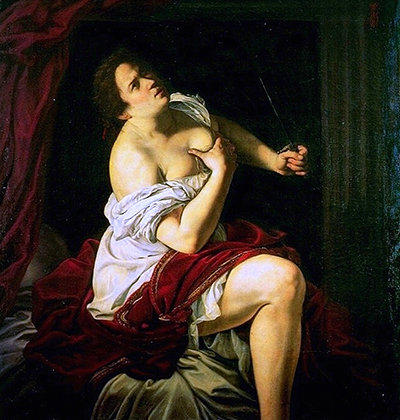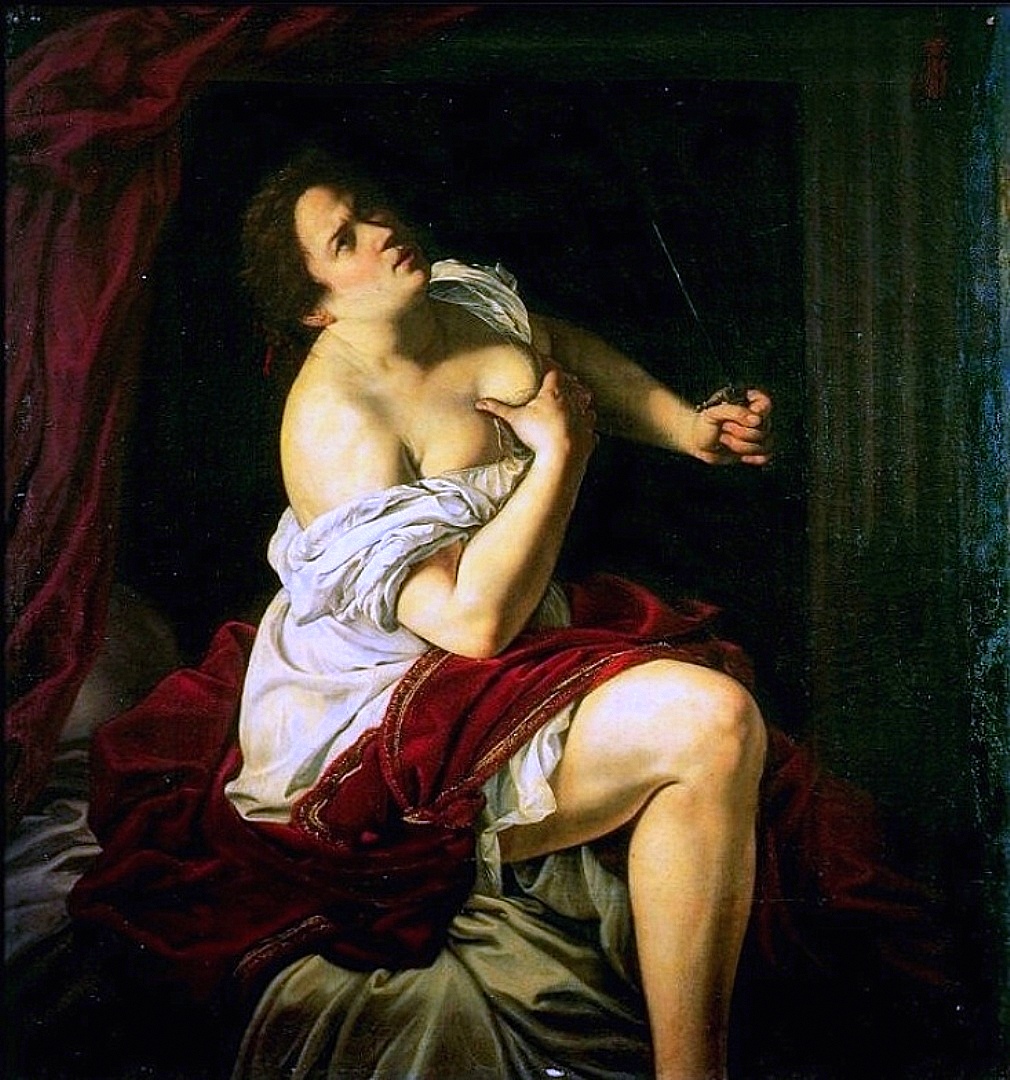Lucretia by Artemisia Gentileschi was painted in 1621 in oil on canvas. It depicts the Roman Heroine, Lucretia as she takes a dagger to her breast, ready to take her own life. The suicide of Lucretia was a historically famous event that had far reaching consequences.
A married Roman noble woman, Lucretia was subsequently captured and raped by the son of the King of Rome, Tarquinius. Rather than live with the dishonour, Lucretia recounted the ordeal to her husband, before taking her own life in front of him. This act led to a rebellion amongst the outraged citizens of Rome and the King of Rome and his government of the time were overthrown, turning Rome into a Republic. This was an artist who regularly took inspiration from mythological themes, and found these ideally suited to her dramatic style with strong contrasts of lighting which were directly inspired by the work of Caravaggio, via the teachings of her own father.
Artemisia Gentileschi was one of the few female artists painting during the Baroque period of the 17th Century. Her works were heavily influenced by Caravaggio, who also brought the same sense of movement and drama to his paintings. Gentileschi was trained by her father, also a painter, who helped her pursue her artist ambitions in a time when there were few available to women. She enjoyed success during her lifetime, becoming the first women ever to study at the Florentine Accademia di Arte del Disegno, but her legacy has been even greater, with critics praising her as one of the most important women artists of her generation. It is hoped, however, that as society progresses in future generations that she will actually just be considered a great Baroque painter, with her gender not even being an issue of discussion.
Whilst the content found in this painting is highly significant within both the artist’s life and career, the style is also worthy of discussion. There is a uniqueness to elements of this painting that have caused confusion and disagreements within art historian circles. The attribution to her hand alone is entirely accepted, but the precise date of this painting far less so. She developed her style over time but there are no direct matches from the rest of her oeuvre that would have enabled us to confidently slot the piece into a specific part of her career. She moved around Italy several times and this brought new influences into her work, as well as allowing her imagination to run free, once she had distanced herself from her father’s studio. Comparisons of those different stylistic iterations with this painting have not unveiled any concrete answers concerning its own date.
The brushwork has been described as mature and precise, as well as confident and bold. The contours particularly hold an aggression that has not been discovered elsewhere in her oeuvre, even after a number of her other paintings were x-rayed to potentially reveal further incomplete work. The relatively fleshy tones have been linked to the earlier part of her career, pointing to the influence of her father. Therefore we find here a painting that boasts characteristics which derive from both her early and more mature periods, with little documentation available to help us cope with this anomaly. There has been a much greater amount of interest in this painter over the past two decades and this has included a deeper evaluation of most of the works in major art galleries and museums.
Artemisia Gentileschi was a feminist and specialised in depicting scenes of historical women, often at pivotal tragic moments in their lives, as is echoed in Lucretia. Gentileschi herself was a victim of rape, and her decision to go to trial against her abuser, painter Agostino Tassi, tarnished her career for many years, with many people interested more in her personal life that her paintings. Gentileschi painted women with greater naturalism and depth, with her women depicted as unashamedly bold and often semi-nude. Although it captures a tragic event, Lucretia is not a victim, her face strong and resolute, one hand solidly clasped to her breast whilst the other firmly holds the dagger. Her strength as a women still pervades, in spite of the tragic circumstance. Some critics have questioned whether or not Gentileschi chose the subject matter of sexual violence against women to capitalise on the fame from her own trial. However, others counter that she was simply trying to create a more balanced view point for women in a time when there was little, if any, artistic equality.
This artwork can now be found in the permanent collection of the Neues Palais, Potsdam, Germany. They have a strong focus on the Baroque era of European art, covering a number of famous names from Italy, plus Flemish and Dutch regions. Key figures to look out for here include the likes of Caravaggio, Guido Reni, Peter Paul Rubens, Anthony van Dyck, Jacob Jordaens and Jan Lievens. Gentileschi, therefore, fits perfectly into that array of artists and they also offer a selection of important German artists from movements which followed on shortly after the Baroque period. Those with the time and inclination to study each and every artwork here will discover a path laid out for them with displays the route of influence across Europe over several centuries of art.





